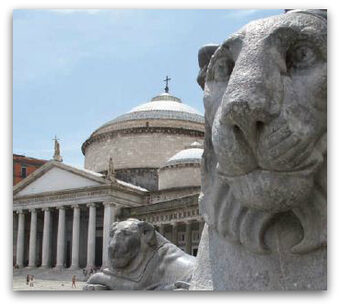
- Church and details
The church was built during the 19th-century work on the largo di Palazzo, the present-day Piazza del Plebiscito, ordered by Gioacchino Murat in 1809 and designed by the architect Leopoldo Laperuta, including the raising of the area of a semi-circular colonnade, the so-called "Murat Forum".
The work was interrupted at the end of Murat's reign and begun again with Ferdinand I, who announced a new call for tender, this time for the building of a church whose purpose was to fulfil a vow made to S. Francesco di Paola to recover the kingdom.
The work was assigned to Pietro Bianchi and from 1817 to 1836 the Church of S. Francesco di Paola was erected and the portico built by Murat was completed. The Basilica built in imitation of the Pantheon at the very centre of the portico dominates the composition with its high dome and wide tambour. The church is entered through a wide pronaos of six columns surmounted by a triangular tympanum at the top of which is the statue of Religion, to the right that of S. Ferdinand of Castile and to the left S. Francis of Paola.
In the interior, there is first an atrium with two circular side chapels, and then a large circular space surmounted by the impressive calcareous stone dome with painted panels and rose windows, 53 metres high and supported by 34 marble columns. Above the colonnade is the royal balcony covered by a baldachin help up by four angels in gilded wood. On high pedestals stand eight marble statues dating back to the construction of the church, as are the canvas paintings in the chapels.
The main altar in polychrome marble, hard stones and lapislazuli, which was designed by Ferdinando Fuga, was taken to pieces and transferred here from the Church of SS. Apostoli. On the wall of the apse hangs the large painting by Vincenzo Camuccini showing St. Francis of Paola bringing the young Alexander back to life (1830).